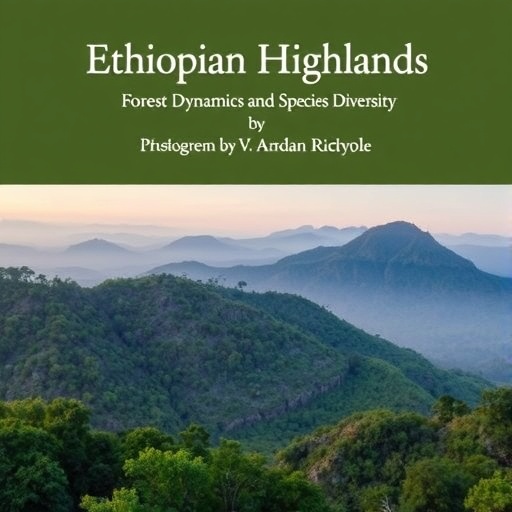In recent years, the ecological significance of church forests in Ethiopia has garnered increased attention from scientists and conservationists. These unique patches of greenery, often nestled amidst agricultural landscapes, serve as crucial reference systems for understanding forest dynamics. In a groundbreaking study by Debie, the multifaceted roles of church forests in the Highlands of Ethiopia are meticulously explored, offering insights into successional pathways, regeneration dynamics, and species composition across different forest types.
The study highlights that church forests are not merely remnants of a bygone era; they are vibrant ecological refuges that harbor a diverse range of species and contribute to vital ecosystem services. These sacred groves typically encompass diverse plant species, some of which are endemic to the region, making the conservation of these areas vital for biodiversity preservation. The unique blend of flora found in these forests plays a significant role in supporting various fauna, including numerous bird species and pollinators. This interconnectedness emphasizes the crucial role that these sacred spaces play in maintaining ecological balance.
One of the remarkable findings of the study is the various successional pathways exhibited within church forests. These pathways are shaped by local climatic conditions, soil characteristics, and human influences. Debie noted that some church forests experience relatively rapid regeneration due to their protection from logging and land conversion, while others may show slower recovery rates. Understanding these dynamics not only sheds light on the ecological value of church forests but also has implications for broader forest management practices throughout the region.
Regeneration dynamics within these ecosystems further highlight the importance of church forests in the landscape. The study reveals that while some species thrive in the shaded understory, others require more light and tend to colonize the outer edges of the forest. This variation in light preferences is crucial in understanding how these ecosystems respond to disturbances, whether natural or anthropogenic. Effective management strategies can then be devised to support the recovery and resilience of these forests, ensuring they continue to flourish in the face of changing environmental conditions.
Moreover, the study extensively analyzes the species composition of these church forests. By employing comprehensive field surveys and analyses, Debie meticulously cataloged the various tree and plant species present. The results indicated a remarkable diversity, with several species showing different degrees of adaptability to climatic conditions. This rich species composition not only adds to the aesthetic value of these forests but also enhances their ability to provide ecosystem services such as carbon sequestration, soil stability, and water regulation.
One of the most intriguing aspects of Debie’s research is the potential for church forests to serve as models for sustainable land-use practices. The findings suggest that these sacred areas, often revered by local communities, play a vital role in fostering traditional ecological knowledge. By integrating indigenous wisdom with scientific research, there is an opportunity to create synergies that benefit both conservation efforts and local livelihoods. These church forests can serve as living laboratories for experimenting with sustainable forestry techniques that could be applied in other areas facing similar environmental challenges.
Furthermore, the role of community engagement in the conservation of church forests cannot be overstated. The study indicates that involving local populations in the preservation and management of these forests significantly enhances stewardship efforts. Community-led initiatives that emphasize the intrinsic value of these ecosystems contribute to a culture of conservation and sustainable resource use. This social aspect of forest management is crucial for ensuring the long-term viability of church forests, as local communities often hold the keys to innovative solutions.
As the global community grapples with the challenges of climate change, the ecological services offered by church forests take on even greater significance. They act as critical buffers against climate-related disruptions, promoting resilience in surrounding landscapes. The study underscores the urgency of protecting these forested areas, as they are not merely sanctuaries for wildlife; they play a pivotal role in enhancing the overall health of the environment. Restoring and conserving church forests may well be a vital strategy for combating climate change impacts in the region.
However, the pressure on these ecosystems is palpable. Increased agricultural expansion and land conversion pose significant threats to the integrity of church forests. The findings of this study serve as a clarion call for policymakers to recognize the value of these forests as integral components of sustainable development. Strategic interventions that prioritize the protection of church forests could yield beneficial outcomes for local communities, biodiversity, and the climate at large.
In conclusion, Debie’s research reveals the profound ecological and cultural importance of church forests in the highlands of Ethiopia. His findings shed light on the intricacies of successional pathways, regeneration dynamics, and diverse species compositions within these unique ecosystems. The study not only furthers our understanding of forest ecology but also promotes the concept of church forests as essential components of sustainable land management. As such, they represent a beacon of hope amidst environmental challenges, offering pathways to a more ecologically harmonious future.
In the landscape of scientific inquiry, the exploration of church forests provides a lens through which to view a broader narrative: one of resilience, regeneration, and a harmonious coexistence with nature. As we ponder the implications of such research, we are reminded that the future of our planet may often hinge on the protection and revitalization of our most sacred spaces.
Subject of Research: Church forests in the Highlands of Ethiopia
Article Title: Church forests as reference systems: successional pathways, regeneration dynamics, and species composition across forest types in the highlands of Ethiopia
Article References:
Debie, E. Church forests as reference systems: successional pathways, regeneration dynamics, and species composition across forest types in the highlands of Ethiopia.
Environ Monit Assess 197, 1361 (2025). https://doi.org/10.1007/s10661-025-14811-y
Image Credits: AI Generated
DOI: https://doi.org/10.1007/s10661-025-14811-y
Keywords: church forests, ecology, Ethiopia, biodiversity, conservation, sustainable land management, regeneration dynamics.




